
First-order hold
Encyclopedia
The first-order hold is a mathematical model of the practical reconstruction of sampled signals that could be done by a conventional digital-to-analog converter
(DAC) and an analog circuit called an integrator
. For the FOH, the signal is reconstructed as a piecewise linear approximation to the original signal that was sampled. A mathematical model such as the FOH (or, more commonly, the zero-order hold
) is necessary because, in the sampling and reconstruction theorem
, a sequence of dirac impulses
, xs(t), representing the discrete samples, x(nT), is low-pass filter
ed to recover the original signal that was sampled, x(t). However, outputting a sequence of dirac impulses is decidedly impractical. Devices can be implemented, using a conventional DAC and some linear analog circuitry, to reconstruct the piecewise linear output for either the predictive or delayed FOH.
Even though this is not what is physically done, an identical output can be generated by applying the hypothetical sequence of dirac impulses, xs(t), to a linear, time-invariant system, otherwise known as a linear filter
with such characteristics (which, for an LTI system, are fully described by the impulse response
) so that each input impulse results in the correct piecewise linear function in the output.
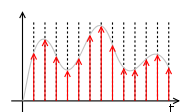 The first-order hold is the hypothetical filter
The first-order hold is the hypothetical filter
or LTI system that converts the ideally sampled signal
Digital-to-analog converter
In electronics, a digital-to-analog converter is a device that converts a digital code to an analog signal . An analog-to-digital converter performs the reverse operation...
(DAC) and an analog circuit called an integrator
Integrator
An integrator is a device to perform the mathematical operation known as integration, a fundamental operation in calculus.The integration function is often part of engineering, physics, mechanical, chemical and scientific calculations....
. For the FOH, the signal is reconstructed as a piecewise linear approximation to the original signal that was sampled. A mathematical model such as the FOH (or, more commonly, the zero-order hold
Zero-order hold
The zero-order hold is a mathematical model of the practical signal reconstruction done by a conventional digital-to-analog converter . That is, it describes the effect of converting a discrete-time signal to a continuous-time signal by holding each sample value for one sample interval...
) is necessary because, in the sampling and reconstruction theorem
Nyquist–Shannon sampling theorem
The Nyquist–Shannon sampling theorem, after Harry Nyquist and Claude Shannon, is a fundamental result in the field of information theory, in particular telecommunications and signal processing. Sampling is the process of converting a signal into a numeric sequence...
, a sequence of dirac impulses
Dirac delta function
The Dirac delta function, or δ function, is a generalized function depending on a real parameter such that it is zero for all values of the parameter except when the parameter is zero, and its integral over the parameter from −∞ to ∞ is equal to one. It was introduced by theoretical...
, xs(t), representing the discrete samples, x(nT), is low-pass filter
Low-pass filter
A low-pass filter is an electronic filter that passes low-frequency signals but attenuates signals with frequencies higher than the cutoff frequency. The actual amount of attenuation for each frequency varies from filter to filter. It is sometimes called a high-cut filter, or treble cut filter...
ed to recover the original signal that was sampled, x(t). However, outputting a sequence of dirac impulses is decidedly impractical. Devices can be implemented, using a conventional DAC and some linear analog circuitry, to reconstruct the piecewise linear output for either the predictive or delayed FOH.
Even though this is not what is physically done, an identical output can be generated by applying the hypothetical sequence of dirac impulses, xs(t), to a linear, time-invariant system, otherwise known as a linear filter
Electronic filter
Electronic filters are electronic circuits which perform signal processing functions, specifically to remove unwanted frequency components from the signal, to enhance wanted ones, or both...
with such characteristics (which, for an LTI system, are fully described by the impulse response
Impulse response
In signal processing, the impulse response, or impulse response function , of a dynamic system is its output when presented with a brief input signal, called an impulse. More generally, an impulse response refers to the reaction of any dynamic system in response to some external change...
) so that each input impulse results in the correct piecewise linear function in the output.
Basic first-order hold

Filter (signal processing)
In signal processing, a filter is a device or process that removes from a signal some unwanted component or feature. Filtering is a class of signal processing, the defining feature of filters being the complete or partial suppression of some aspect of the signal...
or LTI system that converts the ideally sampled signal
-

to the piecewise linear signal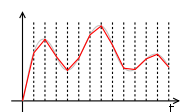

resulting in an effective impulse response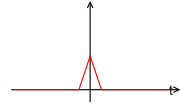 Impulse responseIn signal processing, the impulse response, or impulse response function , of a dynamic system is its output when presented with a brief input signal, called an impulse. More generally, an impulse response refers to the reaction of any dynamic system in response to some external change...
Impulse responseIn signal processing, the impulse response, or impulse response function , of a dynamic system is its output when presented with a brief input signal, called an impulse. More generally, an impulse response refers to the reaction of any dynamic system in response to some external change...
of
-

- where
 is the triangular function.
is the triangular function.
The effective frequency response is the continuous Fourier transformContinuous Fourier transformThe Fourier transform is a mathematical operation that decomposes a function into its constituent frequencies, known as a frequency spectrum. For instance, the transform of a musical chord made up of pure notes is a mathematical representation of the amplitudes of the individual notes that make...
of the impulse response.




- where
 is the sinc function.
is the sinc function.
The Laplace transform transfer functionTransfer functionA transfer function is a mathematical representation, in terms of spatial or temporal frequency, of the relation between the input and output of a linear time-invariant system. With optical imaging devices, for example, it is the Fourier transform of the point spread function i.e...
of the FOH is found by substituting s = i 2 π f:



This is an acausal system in that the linear interpolation function moves toward the value of the next sample before such sample is applied to the hypothetical FOH filter. This acausality is also reflected in the impulse response of the FOH filter beginning to respond before impulse is applied.
Delayed first-order hold
The delayed first-order hold, sometimes called causal first-order hold, is identical to the FOH above except that its output is delayed by one sample period resulting in a delayed piecewise linear output signal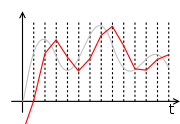

resulting in an effective impulse response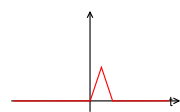 Impulse responseIn signal processing, the impulse response, or impulse response function , of a dynamic system is its output when presented with a brief input signal, called an impulse. More generally, an impulse response refers to the reaction of any dynamic system in response to some external change...
Impulse responseIn signal processing, the impulse response, or impulse response function , of a dynamic system is its output when presented with a brief input signal, called an impulse. More generally, an impulse response refers to the reaction of any dynamic system in response to some external change...
of
-

- where
 is the triangular function.
is the triangular function.
The effective frequency response is the continuous Fourier transformContinuous Fourier transformThe Fourier transform is a mathematical operation that decomposes a function into its constituent frequencies, known as a frequency spectrum. For instance, the transform of a musical chord made up of pure notes is a mathematical representation of the amplitudes of the individual notes that make...
of the impulse response.




- where
 is the sinc function.
is the sinc function.
The Laplace transform transfer functionTransfer functionA transfer function is a mathematical representation, in terms of spatial or temporal frequency, of the relation between the input and output of a linear time-invariant system. With optical imaging devices, for example, it is the Fourier transform of the point spread function i.e...
of the delayed FOH is found by substituting s = i 2 π f:



The delayed output makes this a causal systemCausal systemA causal system is a system where the output depends on past/current inputs but not future inputs i.e...
. The impulse response of the delayed FOH does not respond before the input impulse.
This kind of delayed piecewise linear reconstruction is physically realizable by implementing a digital filterDigital filterIn electronics, computer science and mathematics, a digital filter is a system that performs mathematical operations on a sampled, discrete-time signal to reduce or enhance certain aspects of that signal. This is in contrast to the other major type of electronic filter, the analog filter, which is...
of gain H(z) = 1 − z−1, applying the output of that digital filter (which is simply x[n]−x[n−1]) to an ideal conventional digital-to-analog converterDigital-to-analog converterIn electronics, a digital-to-analog converter is a device that converts a digital code to an analog signal . An analog-to-digital converter performs the reverse operation...
(that has an inherent zero-order holdZero-order holdThe zero-order hold is a mathematical model of the practical signal reconstruction done by a conventional digital-to-analog converter . That is, it describes the effect of converting a discrete-time signal to a continuous-time signal by holding each sample value for one sample interval...
as its model) and integratingIntegratorAn integrator is a device to perform the mathematical operation known as integration, a fundamental operation in calculus.The integration function is often part of engineering, physics, mechanical, chemical and scientific calculations....
(in continuous-time, H(s) = 1/(sT)) the DAC output.
Predictive first-order hold
Lastly, the predictive first-order hold is quite different. This is a causal hypothetical LTI system or filter that converts the ideally sampled signal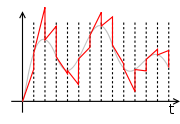



into a piecewise linear output such that the current sample and immediately previous sample are used to linearly extrapolate up to the next sampling instance. The output of such a filter would be



resulting in an effective impulse response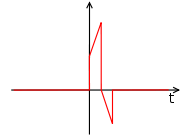 Impulse responseIn signal processing, the impulse response, or impulse response function , of a dynamic system is its output when presented with a brief input signal, called an impulse. More generally, an impulse response refers to the reaction of any dynamic system in response to some external change...
Impulse responseIn signal processing, the impulse response, or impulse response function , of a dynamic system is its output when presented with a brief input signal, called an impulse. More generally, an impulse response refers to the reaction of any dynamic system in response to some external change...
of



- where
 is the rectangular function and
is the rectangular function and  is the triangular function.
is the triangular function.
The effective frequency response is the continuous Fourier transformContinuous Fourier transformThe Fourier transform is a mathematical operation that decomposes a function into its constituent frequencies, known as a frequency spectrum. For instance, the transform of a musical chord made up of pure notes is a mathematical representation of the amplitudes of the individual notes that make...
of the impulse response.




- where
 is the sinc function.
is the sinc function.
The Laplace transform transfer functionTransfer functionA transfer function is a mathematical representation, in terms of spatial or temporal frequency, of the relation between the input and output of a linear time-invariant system. With optical imaging devices, for example, it is the Fourier transform of the point spread function i.e...
of the predictive FOH is found by substituting s = i 2 π f:



This a causal systemCausal systemA causal system is a system where the output depends on past/current inputs but not future inputs i.e...
. The impulse response of the predictive FOH does not respond before the input impulse.
This kind of piecewise linear reconstruction is physically realizable by implementing a digital filterDigital filterIn electronics, computer science and mathematics, a digital filter is a system that performs mathematical operations on a sampled, discrete-time signal to reduce or enhance certain aspects of that signal. This is in contrast to the other major type of electronic filter, the analog filter, which is...
of gain H(z) = 1 − z−1, applying the output of that digital filter (which is simply x[n]−x[n−1]) to an ideal conventional digital-to-analog converterDigital-to-analog converterIn electronics, a digital-to-analog converter is a device that converts a digital code to an analog signal . An analog-to-digital converter performs the reverse operation...
(that has an inherent zero-order holdZero-order holdThe zero-order hold is a mathematical model of the practical signal reconstruction done by a conventional digital-to-analog converter . That is, it describes the effect of converting a discrete-time signal to a continuous-time signal by holding each sample value for one sample interval...
as its model) and applying that DAC output to an analog filter with transfer function H(s) = (1+sT)/(sT).
See also
- Nyquist–Shannon sampling theoremNyquist–Shannon sampling theoremThe Nyquist–Shannon sampling theorem, after Harry Nyquist and Claude Shannon, is a fundamental result in the field of information theory, in particular telecommunications and signal processing. Sampling is the process of converting a signal into a numeric sequence...
- Zero-order holdZero-order holdThe zero-order hold is a mathematical model of the practical signal reconstruction done by a conventional digital-to-analog converter . That is, it describes the effect of converting a discrete-time signal to a continuous-time signal by holding each sample value for one sample interval...
- Bilinear interpolationBilinear interpolationIn mathematics, bilinear interpolation is an extension of linear interpolation for interpolating functions of two variables on a regular grid. The interpolated function should not use the term of x^2 or y^2, but x y, which is the bilinear form of x and y.The key idea is to perform linear...
External links
- where
- where
-

